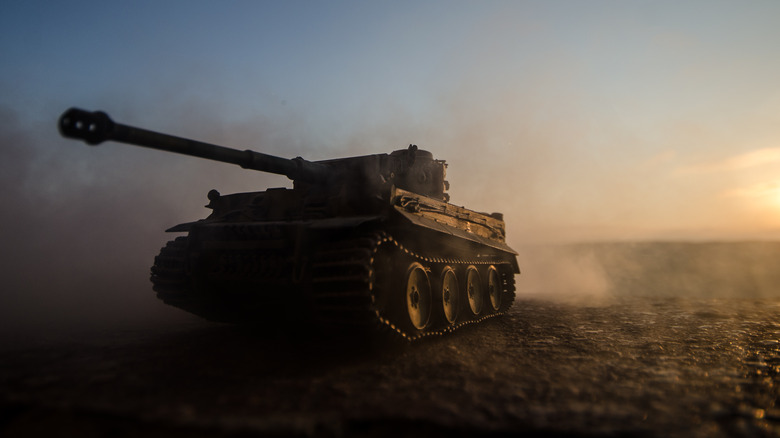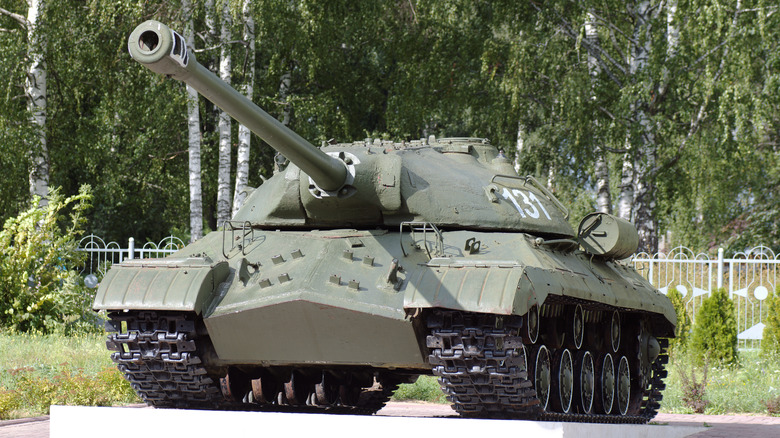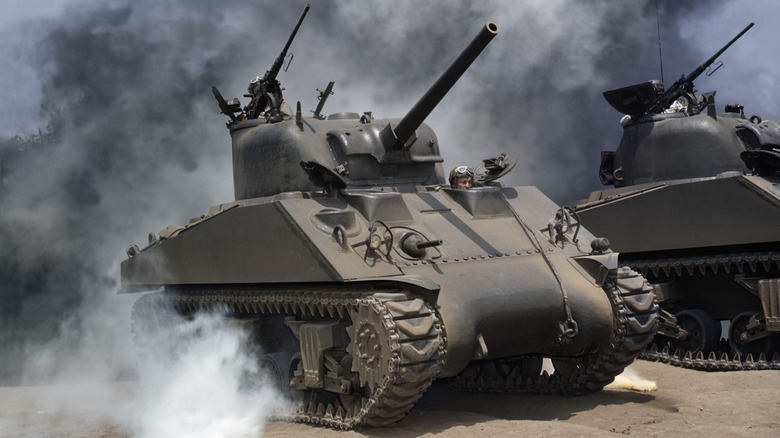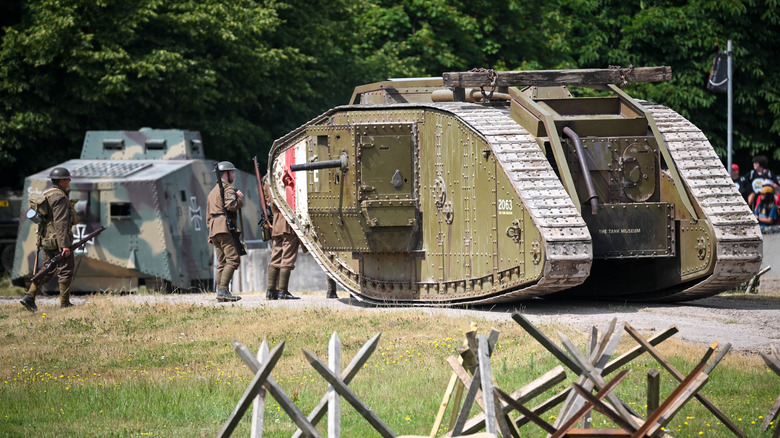10 Of The Most Fearsome Military Tanks Ever Built
Of all the vehicles and weapons that a soldier can encounter in the battlefield, few have the ability to terrorize and intimidate the enemy as tanks. Since their introduction into warfare at the start of the 20th century, these armored vehicles have become a vital part of any military and are rightly feared by infantry troops.
Tanks are so fearsome for a number of reasons. They are huge structures that are totally encased in thick metal armor, can trample over or through defenses, and have deadly weaponry that can destroy targets far off into the distance. All of this gives them an aura of invulnerability and a sense that they are capable of destroying anything in their path. The most impressive and terrifying tanks take this to the extreme. They are bigger and more powerful, with scary designs that inspire dread. While they may not be as effective as other tanks, anyone seeing these beasts loom over the horizon probably wouldn't stick around to find out.
T-35
The T-35 is a Soviet tank that was developed in the period between World War I and World War II. It went into production in the 1930s and entered service in 1935, serving until 1941. While it did see some limited action during the early parts of WWII, it was largely untested on the battlefield. But that doesn't mean that the T-35 wasn't a fearsome tank that would likely have shocked anyone who had the misfortune of seeing it.
Nicknamed the Land Battleship, this vehicle was a multi-turreted heavy tank. Weighing 45 tons with a length of 33 feet, height of 11 feet, and width of 10 feet, they were hulking machines that could overshadow almost any other vehicle they came across. The tank was intended to break through enemy lines and devastate combatants thanks to an ability to shoot rounds in every direction.
The T-35 was heavily armed to meet that objective, being the first operational tank in the world to feature up to five different weapons. These included the main cannon in the form of a 75 mm gun KT-28, along with two 45mm high-velocity cannons and several DT machine guns. Depending on the particular tank, there could be up to five of these DT machine guns, situated so that they could fire in every direction away from the T-35.
Churchill Crocodile
Although most tanks today follow a very similar design philosophy, to the point that it can be difficult to tell them apart, that hasn't always been the case. Various manufacturers and governments have experimented with strange tank prototypes that, in some cases, didn't even make it to the battlefield. While the Churchill Crocodile did see combat, it would be hard to argue against the fact that it was an unusual tank seeing as it was essentially a giant armored flamethrower — something that would scare even the most hardened soldiers on the battlefield.
The Churchill Crocodile followed a World War II trend that saw multiple countries create flame-throwing tanks. Essentially a modified Mk IV (A22) Churchill infantry tank, this variant was introduced in 1944 and went on to serve for several years after the conflict ended. It featured an Ordnance QF 75 mm main gun and flame projector with a range of around 100 yards. Using petrol from the main fuel tank as an initial ignition source, it could shoot fire in a continuous stream or in short bursts for a maximum duration of almost a minute and a half. It proved incredibly effective against short range targets in bunkers and was terrifying to behold, with German forces often surrendering before it could reach them due to the fear factor it possessed.
Tiger
The Tiger tanks were the most feared of the Axis' weapons in World War II. While Germany had made good use of the Panzer tanks in the early parts of the war, their leaders wanted a heavier tank that relied more on firepower and brute strength than mobility and speed. Initial designs for the first Tiger tank came in 1937, but it wasn't put into full production until 1941. By that time, the Tiger had been altered to be even heavier and larger than initially planned.
Thousands of the Tiger 1 were produced during the war as it garnered a terrible reputation and was rightly feared by Allied forces. Weighing 45 tons, it was armed with a 88mm gun that was capable of shooting straight through many tanks of the time and was effective at ranges of up to a mile. Combined with its massive size and armor that often seemed indestructible, the Tiger 1 was highly effective.
The tank also formed the basis of the more powerful Tiger 2. This upgraded version of the Tiger tank had even thicker armor and weighed 30 tons more. A sloped design also helped protect this model from incoming shells and made it even harder to destroy.
Challenger 2
The Challenger 2 is the British third generation main battle tank. An evolution of the earlier Challenger 1, it officially entered production at the start of the 1990s, with the tank entering active service by 1998. Having established a reputation for reliability and effectiveness, the Challenger 2 has seen combat in a variety of conflicts around the world, including Afghanistan, Iraq, and Kosovo at the hands of the British Army as well in Ukraine against Russian forces.
The Challenger 2 has a bulked-up appearance and weighs up to 75 tons. This helps it stand out against other third generation tanks and gives it a hardened look that makes it seem like it could survive anything, which is backed up by its reputation for being incredibly hard to destroy. In fact, until the war in Ukraine, no Challenger 2 had been destroyed by enemy fire. Such a combat record would surely make any enemy forces think twice about engaging the tank in combat.
That doesn't mean the Challenger 2 is all about survivability. It is also deadly and comes equipped with a 120 mm L30 rifled gun and two 7.62 mm chain guns. These weapons allow the tank to fire a range of rounds, from L31 high explosive squash head ammo to the L27A1 armor-piercing fin-stabilized discarding sabot rounds.
Type 99
As one of the most heavily armed tanks in the world, the Chinese-made Type 99 tank is a formidable piece of military hardware. Anyone coming across it would likely understand just how capable this vehicle is, thanks to its large gun, and the fact that it has a distinctive low profile. This gives the ZTZ-99 — as it is officially known — a fierce appearance that immediately stands out. Of course, you can also throw in the fact that this particular tank will appear in huge numbers on the battlefield. Over 1,200 Type 99 tanks have been built so far, meaning that any opponent of China that faces down this tank is unlikely to see just one at a time.
Developed to replace the aging Type 88 tanks that first entered service in the 1980s, the Type 99 is a modern main battle tank that has been part of the Chinese military for more than two decades. In those years, it has received several revisions and upgrades, pushing its weight in excess of 50 tons. Loaded with advanced tech, the scariest part of the Chinese-made tank is its ZPT-98 125 mm smoothbore gun, which is capable of firing a variety of ammo types including anti-tank missiles and depleted uranium rounds that can penetrate even the best armor.
Char 2C
Among the largest military tanks ever built, the Char 2C would likely have been a hugely imposing sight on any battlefield simply because of its size. The entire design process of this tank was to create an armored vehicle that was larger than any other. Like many tanks of the era, it had limited mobility and the technology of the time led to it being excessively heavy. Development of the Char 2C began during the First World War, but it didn't enter active service until several years after the conflict ended in 1921.
The relative peace between the two world wars meant that it saw very little combat action. But standing some 33 feet long and weighing an estimated 77 tons, the Char 2C was a monster of a vehicle that required 12 individuals to crew it. It came armed with a 75 mm Canon de 75 modèle 1897 main gun and four 8 mm Hotchkiss Mle 1914. Only a small number of this model were produced, and by the time the Second World War began, it was outdated. Most were intentionally destroyed to stop them from falling into Germany's hands, with the Char 2C largely fulfilling a propaganda role for the French military during its lifetime.
TOS-1 Buratino
Some people may not consider this to be a tank in the traditional sense, but the TOS-1 Buratino is an armored vehicle with a tremendous amount of firepower. Essentially, it is a multiple rocket launcher mounted on the chassis of a main battle tank. In the case of the TOS-1, this is usually a T-72 or a T-90, with the main gun replaced with a launcher that is made up of three rows of eight tubes. These are capable of firing a variety of missiles and rockets, including incendiary rounds and thermobaric.
A simple look at the TOS-1 is enough to make you realize that it is a machine capable of causing widespread destruction. The sight of such a large rocket launcher system attached to a tank is terrifying enough, but knowing that these vehicles can fire thermobaric rockets makes it one of the most feared tanks in the world. Thermobaric rockets are a devastatingly destructive weapon. Sometimes called a vacuum bomb, thermobaric weapons work by releasing a large cloud of explosive material when they initially hit the ground. Moments after the first impact, a second explosion is triggered, which quickly spreads and causes a massive fireball. It is widely used against targets in defensive positions that are difficult to hit with traditional bombs and rockets, as the cloud is able to spread into hard to reach locations.
IS-3
The IS-3 — also known as the Object 703 — is a Soviet Union tank that entered service in the latter stages of World War II. Although it saw no combat in the war due to its late arrival, it would play a significant role in conflicts that followed, and up until the end of the Cold War, it made up a significant portion of the Soviet Union's armored divisions. A heavy tank, the IS-3 was designed to be able to withstand large amounts of punishment and strike targets with powerful weaponry. It did this mainly through a 122mm Gun D-25 cannon and armor that was up to nine inches thick.
As soon as other nations got a look at the IS-3 tank, it set off alarm bells and led to a flurry of projects in the likes of the United States to try and create a tank that could rival it. It had a distinctive domed head and turret as well as angular armor on its front and rear. This was completely original for the time period and established a signature model for Soviet tanks over the next few decades. The strange design was an attempt to deflect incoming projectiles and definitely made the IS-3 look terrifying.
M4 Sherman
By the time of World War II, every major nation had a large number of tanks with designs for light, medium, and heavy versions of the vehicles. Within the United States' military, the M4 Sherman tank was among the most heavily produced and widely used in combat. The simplicity of the design made it cheap and fast to manufacture, leading to it being produced in large numbers. Helping to push through infantry lines and spearhead attacks, the M4 Sherman is one of the most successful tanks in history and almost 50,000 were put into service
While the standard M4 tank was menacing in its own way, with a 75 mm gun M3 main gun and up to seven inches or armor, it was the wide array of specialized variants that were truly frightening. One of these was the Sherman M4A3 "Zippo" Tank, which had a mounted flamethrower that could shoot fire at a range of up to 150 yards. This made it perfect for the Pacific campaign, with American troops utilizing the tank variant to rid caves and underground tunnels of Japanese soldiers.
There was also the Sherman Crab, essentially a M4 tank with a rotating chain flail attached to the front. This terrifying version looks like something out of a horror film and was meant to clear the field of landmines, with the chain spinning at high speed with enough power to safely detonate mines in front of the armored vehicle.
British Mark 1
The British Mark 1 was essentially the world's first tank. Invented for combat during the First World War, the armored vehicle was an evolution of earlier vehicles that first entered combat in 1916. By the end of the war, more than 150 Mark 1 tanks had been produced and it set a standard that all future tanks would follow despite the fact that it looked very different from what people would consider main battle tanks today. For instance, the Mark 1 lacks the large gun associated with tanks, have a rhomboidal shape, and tracks that cover the entire length and height of the tank. This was necessary in order to allow the tanks to cross trenches and stay mobile on the muddy battlefields of Europe.
Before the Mark 1, nothing like this had ever been seen in combat before. The sight of a hulking metal beast that weighed dozens of tons and moved at an ominous 3.6 mph would have likely caused terror in infantry troops. Especially when you consider that the tank was armed with a machine gun and six-pound cannon on each side as a way of attacking enemy forces. While they were limited in terms of their effectiveness in battle, the Mark I was unlike anything else that had come before it and certainly looked invulnerable even if it wasn't in reality.










